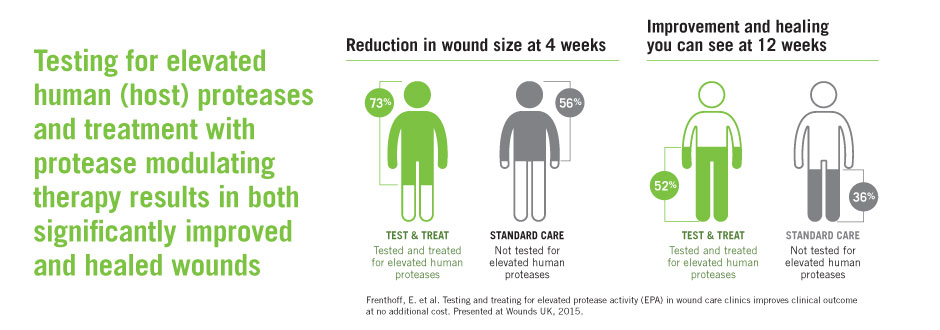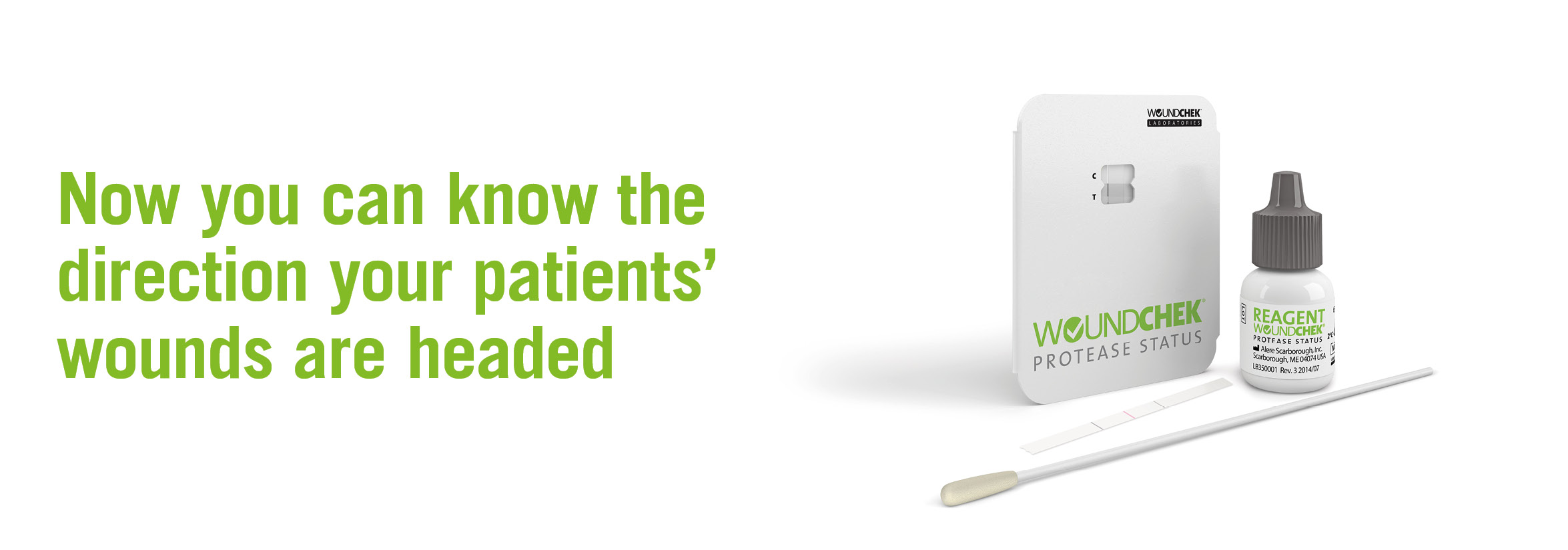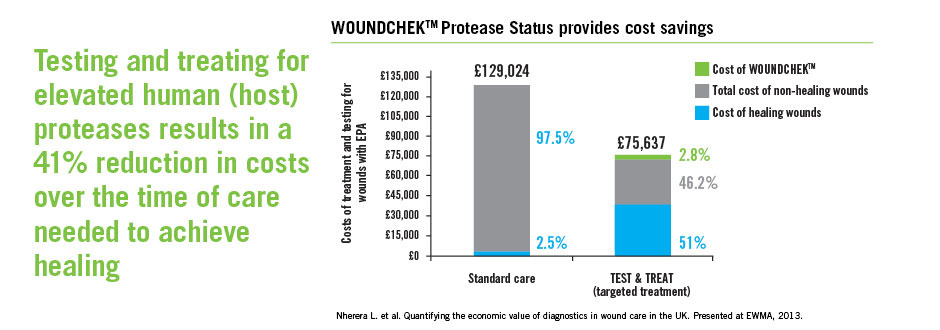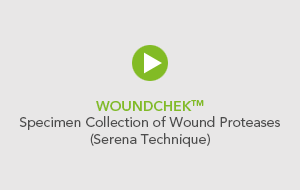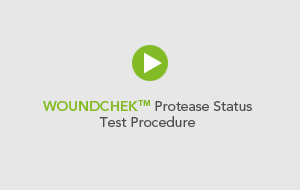The Only Test to Detect EPA
Developed to aid wound assessment and help clinicians target advanced wound care therapies more effectively, WOUNDCHEK™ Protease Status is able to detect EPA (elevated protease activity). As there are no visual cues for EPA, wounds with EPA have so far gone undetected1Snyder R. et al. A survey: The importance of proteases in wound healing and wound assessment. Poster, Wounds UK 2011..
WOUNDCHEK™ Protease Status will help clinicians establish within minutes which wounds may most benefit from a protease modulating therapy, ensuring appropriate and targeted use of these therapies.
WOUNDCHEK™ Protease Status product sizes — Available in countries accepting CE mark!
|
PRODUCT CODE |
DESCRIPTION |
CONTAINS |
|
350006 |
WOUNDCHEK™ Protease Status |
6 tests (all material needed) |
|
350010 |
WOUNDCHEK™ Protease |
3 elevated result and |
Videos
Disclaimer:
The product information on this page is not intended for, or to be used by health care professionals or users in the United States
Evidence
Posters & Articles
![]() Serena TE, et al, 2016. Defining a new diagnostic assessment parameter for wound care: Elevated protease activity, an indicator of nonhealing, for targeted protease-modulating treatment
Serena TE, et al, 2016. Defining a new diagnostic assessment parameter for wound care: Elevated protease activity, an indicator of nonhealing, for targeted protease-modulating treatment
![]() Lazaro J., et al, 2016. Elevated levels of matrix metalloproteinases and chronic wound healing: an updated review of clinical evidence
Lazaro J., et al, 2016. Elevated levels of matrix metalloproteinases and chronic wound healing: an updated review of clinical evidence
![]() Izzo I., et al, 2014. High matrix metalloproteinase levels are associated with dermal graph failure in diabetic foot ulcers
Izzo I., et al, 2014. High matrix metalloproteinase levels are associated with dermal graph failure in diabetic foot ulcers
![]() Frenthoff, E. et al. 2015. Testing and treating for elevated protease activity (EPA) in wound care clinics improves clinical outcome at no additional cost
Frenthoff, E. et al. 2015. Testing and treating for elevated protease activity (EPA) in wound care clinics improves clinical outcome at no additional cost
![]() Uccioli, L. et al. 2014. The presence of elevated protease activity (EPA) influences the integration of dermal grafts in diabetic foot ulcers
Uccioli, L. et al. 2014. The presence of elevated protease activity (EPA) influences the integration of dermal grafts in diabetic foot ulcers
![]() Gibson, M. et al. 2013. Testing chronic wounds for EPA. The benefits of testing all wounds, whether assessed as healing or non-healing
Gibson, M. et al. 2013. Testing chronic wounds for EPA. The benefits of testing all wounds, whether assessed as healing or non-healing
![]() Ivory, 2013. The cost implications of implementing Woundchek Protease Status into clinical practice
Ivory, 2013. The cost implications of implementing Woundchek Protease Status into clinical practice
![]() Ivory, 2013. Assessing chronic non healing wounds for elevated protease activity
Ivory, 2013. Assessing chronic non healing wounds for elevated protease activity
![]() Anichini, R. et al. 2013. Detecting and treating Elevated Protease Activity (EPA) in chronic diabetic wounds
Anichini, R. et al. 2013. Detecting and treating Elevated Protease Activity (EPA) in chronic diabetic wounds
![]() Duteille, F. 2013. Evaluation of the use of point-of-care test for proteases to identify patients with increased risk of skin graft failure
Duteille, F. 2013. Evaluation of the use of point-of-care test for proteases to identify patients with increased risk of skin graft failure
![]() Nherera, L. et al. 2013. Quantifying the economic value of diagnostics in wound care in the UK
Nherera, L. et al. 2013. Quantifying the economic value of diagnostics in wound care in the UK
![]() International case series: Using Promogran/Promogran Prisma on wounds with elevated protease activity: case studies. London: Wounds International, 2013.
International case series: Using Promogran/Promogran Prisma on wounds with elevated protease activity: case studies. London: Wounds International, 2013.
![]() Young, T. 2012. Using a protease test to inform wound care treatment decisions
Young, T. 2012. Using a protease test to inform wound care treatment decisions
![]() Haycocks, 2012. Assessing chronic diabetic foot wounds for elevated protease levels
Haycocks, 2012. Assessing chronic diabetic foot wounds for elevated protease levels
![]() Hodgson, 2012. Clinical skills of tissue viability nurse versus Woundchek to detect elevated protease activity (EPA)
Hodgson, 2012. Clinical skills of tissue viability nurse versus Woundchek to detect elevated protease activity (EPA)
![]() Serena, T. et al. 2012 Preliminary results: Testing for elevated protease activity in clinical practice
Serena, T. et al. 2012 Preliminary results: Testing for elevated protease activity in clinical practice
![]() Johnstone, 2012. Case Studies: Testing for and treating EPA
Johnstone, 2012. Case Studies: Testing for and treating EPA
![]() Cullen, B. et al 2012. Targeted use of Collagen/ORC improves clinical outcome
Cullen, B. et al 2012. Targeted use of Collagen/ORC improves clinical outcome
![]() Serena, T. et al. 2011. Protease activity levels associated with healing status of chronic wounds
Serena, T. et al. 2011. Protease activity levels associated with healing status of chronic wounds
![]() Snyder, R. et al. 2011.The importance of proteases in wound healing and wound assessment
Snyder, R. et al. 2011.The importance of proteases in wound healing and wound assessment
Consensus Documents
![]() Spanish Diabetes Foundation, 2014. Diabetic Foot Ulcers: Prevention, Care and Treatment
Spanish Diabetes Foundation, 2014. Diabetic Foot Ulcers: Prevention, Care and Treatment
![]() DACH, 2013. Die tolle eines proteasen schnelltests in der wunddiagnostik
DACH, 2013. Die tolle eines proteasen schnelltests in der wunddiagnostik
![]() USA, 2013. Using a diagnostic tool to identify elevated protease activity levels in chronic and stalled wounds
USA, 2013. Using a diagnostic tool to identify elevated protease activity levels in chronic and stalled wounds
![]() Wounds International, 2013. EPA made easy.
Wounds International, 2013. EPA made easy.
![]() UK, 2012. Protease diagnostic in wound care
UK, 2012. Protease diagnostic in wound care
![]() International, 2012. Role of proteases in wound diagnostics
International, 2012. Role of proteases in wound diagnostics
![]() Italy, 2012. Significato e valutazione delle proeasi nel processo di riparazione tessutale
Italy, 2012. Significato e valutazione delle proeasi nel processo di riparazione tessutale
![]() Canada, 2012. The role of a point-of-care protease activity diagnostic test in Canadian clinical practice
Canada, 2012. The role of a point-of-care protease activity diagnostic test in Canadian clinical practice
![]() International, 2012.World Union of wound healing societies consensus document
International, 2012.World Union of wound healing societies consensus document
Symposia
Dr. Läuchli, Dr. Anichini, Dr. Dowsett, and Prof. Duteille, EWMA 2013. EPA, guiding treatment decisions for improved clinical results and cost effective care
Dr. Serena, Dr. Fletcher, and Dr. Läuchli, EWMA 2012. Testing for EPA, the arrival of wound diagnostics
Dr. Thoms, Training Event 2012. Proteases: Background, Assessment, and Treatment of EPA in chronic wounds (in German)
Disclaimer:
The product information on this page is not intended for, or to be used by health care professionals or users in the United States
